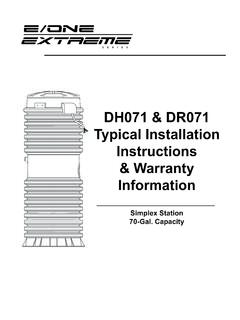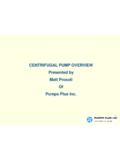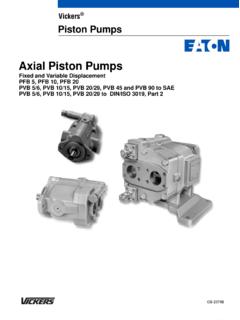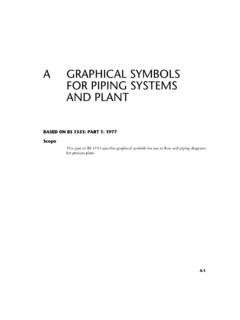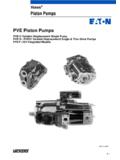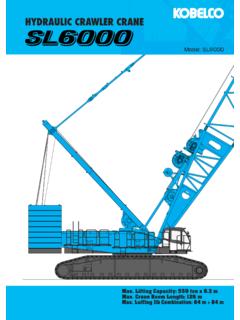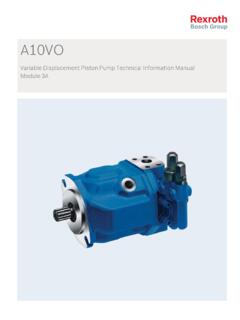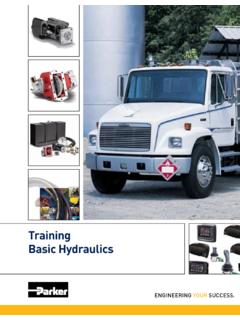Transcription of Low Pressure Sewer Systems Using Environment One Grinder …
1 Low PressureSewer SystemsUsingEnvironment OneGrinder 3 Advantages of LPS Systems .. 3 Description and Operation .. 3 Pump Operation .. 4 Pump Type .. 4 Motor 5 Power Outages .. 7 Power Consumption .. 7 LPS System Design .. 9 Information 9 Grinder Pump Station Size Selection .. 9 Grinder Pump Placement .. 10 Pipe Selection .. 10 System Layout .. 11 Zone Designations .. 12 Completion of Pipe Schedule and Zone Analysis .. 14 Review .. 22 Manufacturer Evaluation List .. 3023 IntroductionE/One low Pressure Sewer (LPS) Systems offer the designer new freedom in solving many problemsituations that have defied reasonably economical solutions Using the conventional LPS system design should be considered on the basis of its own unique circumstances. Onsuch a basis, a sound choice between gravity and low Pressure Systems can be criteria aid the engineer in making a preliminary choice between several alternative sys-tems: entirely low Pressure , entirely gravity, entirely vacuum or a combination of Systems .
2 Thesecriteria are presented and are intended to serve as a general guide. The final decision and designare the responsibility of the project consulting engineer, whose knowledge of local conditions,including construction costs, regulatory requirements and the client s particular needs, become vitalto the preparation of the final designs and of LPS SystemsLPS Systems have low initial (front end) cost compared to gravity Systems , which have nearly all thetotal investment allocated in the first stage. With the LPS system, Grinder pump costs are incurredonly as construction progresses. These costs will be deferred for many years in certain types ofdevelopment LPS system is not subject to infiltration from ground water or from surface storm water enteringthrough leaking pipe joints and manholes. With zero infiltration, treatment plants need not be sizedto handle the peak flow rates caused by infiltration.
3 Treatment efficiencies can be more consistent,and treatment plant operating costs LPS system may become the critical factor in determining whether marginal land can beeconomically developed. Many attractive sites have been considered unsuitable for developmentbecause of the excessive costs typically associated with conventional Sewer Systems sites withhilly terrain, land with negligible slope, high water tables, poor percolation characteristics, rock,seasonal occupancy or low population communities are planning to convert from septic tanks to central sewage collection andtreatment Systems to minimize health hazards and/or environmental deterioration. The majorreduction in cost and the simplicity of installation of an LPS system have strong appeal for suchcommunity improvement programs. Small-diameter pipe Pressure mains can be laid along existingroadways with minimum disruption to streets, sidewalks, lawns, driveways and underground restoration costs are similarly minimized.
4 Sewage delivered to the treatment plant (becauseit contains no infiltration) is more uniform in strength, the volume is smaller, and peaks are and OperationGrinder pumps of approved design accomplish all pumping and sewage-grinding processes forsmall-diameter LPS system consists of conventional drain, waste and vent (DWV) piping within the residenceconnected to the Grinder pump inlet. The Grinder pump may be installed above or below grade,indoors or outdoors. Depending on flow factors and model used, it may serve one or more resi-4dences, or several families in the case of apartment pumps discharge a finely ground slurry into small diameter Pressure piping. In a completelypressurized collection system, all the piping downstream from the Grinder pump (including lateralsand mains) will normally be under low Pressure . Pipe sizes will start at 1 1/4 inches for houseconnections (compared to 4 or 6 inches in gravity Systems ) and will be proportionally smaller thanthe equivalent gravity pipeline throughout the system.
5 All pipes are arranged as zone networkswithout on topography, size of the system and planned rate of buildout, appurtenances mayinclude valve boxes, flushing arrangements, air release valves at significant high points, checkvalves and full-ported stops at the junction of each house connection with the low Pressure OperationLow Pressure Sewer Systems have become feasible with the availability of the Environment Onegrinder pump, the reliability of which has been proven in almost 40 years of service. The grinderpump station provides adequate holding capacity, reliable grinding and Pressure transport of a fineslurry to an existing gravity Sewer , pump station or directly to a wastewater treatment operation, the Grinder pump station will handle sewage and many items that should not, but oftendo, appear in domestic wastewater. For example, plastic, wood, rubber and light metal objects canbe routinely handled without jamming the Grinder or clogging the pump or piping system.
6 The grinderpump will discharge this slurry at a maximum rate of 15 gpm or 11 gpm at a Pressure of 40 sewage several thousand feet to a discharge point at a higher elevation is possible aslong as the sum of the static and friction losses does not exceed design limits of 185 feet TDH (80psig).The Grinder pump is actuated when the depth of the sewage in the tank reaches a predetermined turn-on level, and pumping continues until the turn off level is reached. The pump s running timeis short, power consumption is low, and long pump life is ensured. The unit is protected againstbackflow from discharge lines by an integral check valve. Several Grinder pump station models areavailable to satisfy various total and peak demand TypeThe semi-positive displacement pump in the Grinder pump station has a nearly vertical H-Q is the best type of pump for successful parallel operation of many pumps into a system ofcommon low Pressure mains.
7 Since each pump will be located at a different point along commonlow Pressure mains and at various elevations, each pump should operate in an efficient and predict-able manner, whether one pump or numerous pumps are operating at a given moment; the pumpsin such a system do not have a single fixed operating point, but must operate consistently over awide range of heads that are continually, and often rapidly, Environment One Grinder pump has the capability of operating above the LPS system designcriteria of 80 psig, or 185 feet (Figure 1). Based on the maximum daily number of pumps operatingsimultaneously (Table 3) versus the number of pumps connected to the system at the design pres-sure of 185 feet, the capability to operate significantly above the system s design Pressure is man-datory in order for the system to operate properly during the approximately bimonthly peaks when5the absolute maximum numbers of pumps are operating.
8 This feature also ensures that pumpingwill continue under those conditions when higher than normal Pressure occurs in the designs with calculated heads approaching the upper limits of recommended heads shouldbe reviewed by Environment One application specialists. Contact your local Environment OneRegional Sales Office or authorized distributor for a no-cost, computerized review of your during normal operation, there will be short periods when higher-than-design pres-sures will be experienced. These can result from a variety of causes including solids buildup (ob-structions) or air of solids or air accumulation will be purged from the line since the pump continues toproduce an essentially constant flow, even though the cross section of the pipeline has temporarilybeen reduced. Higher velocities through the reduced cross section will provide the scouring actionneeded to correct such conditions as soon as they start to higher than expected Pressure conditions are transitory occurrences.
9 The only requirementis that no damage be done to the pumping equipment, pipelines or appurtenances during theseoccasional short periods. Environment One Grinder pumps are driven by motors rated for continu-ous operation at 104 F/40 C above ambient temperature. They can operate at 50 percent aboverated Pressure for at least 5 minutes without excessive temperature rise. Based on the Albany, NewYork, demonstration project4, for this type of overload to last even as long as one minute would SelectionA Grinder pump station is an electromechanical system that depends on electric power for its operat-ing, control and alarm functions. The design and selection of Environment One s pump, motor, Grinder and level sensing controls were accomplished by optimizing the wastewater transportfunction of the unit within the necessary constraints for unattended, trouble free operation in aresidential single Grinder pump core is common to all models of Environment One Grinder pumps (modelsDH071, DH151, DH152, DH272 and DH502).
10 This central core contains all of the working andcontrol elements of the unit and is powered by a 1 hp, 240v (or 120v), 1,725 rpm capacitor start,thermally protected induction motor. Each of these motor features was carefully considered in thedesign of the Grinder pump pump should be considered as a residential appliance. For this reason, performing the grindingand pumping functions Using no more than 1 hp to permit occasional use at 120v in older homes notwired for 240v is desirable. In order to achieve the high heads desired and provide constant flow atvarying heads, the 1-hp motor is coupled to a pump of semi-positive displacement design (Figure 1).At a rating of 1 hp and 1,725 rpm, the Environment One Grinder pump develops more than foot-pounds of torque. Motors used to drive centrifugal pumps are often rated at hp at 3,450 rpm andmay produce less torque. When handling residential sewage, grinding torque may be demandedduring any portion of the starting or running cycle.

